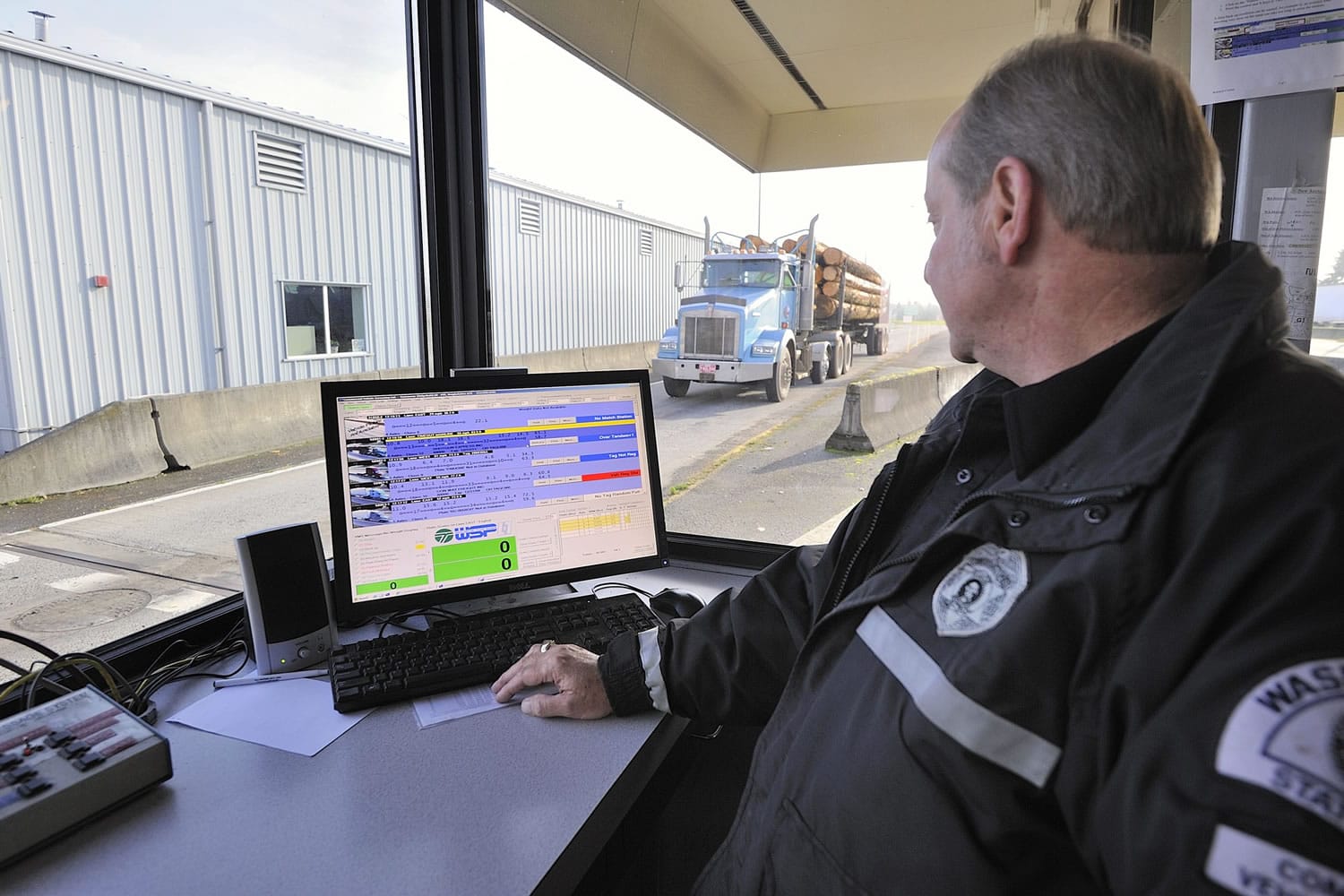RIDGEFIELD — At big truck stops and on CB radios, long-haul tractor-trailer drivers are talking about the Washington State Patrol’s new software that helps discover whether drivers are dog tired from rolling too many hours, and if they have falsified their logbooks.
The new software will help the WSP make freeways and state highways safer.
“The last thing we want is 80,000 pounds crashing through a bunch of cars,” said Robert Schultheis, a commercial vehicle enforcement officer who inspects trucks, and their drivers, at the WSP port of entry weigh station on Interstate 5 northbound in Ridgefield.
All around Washington, officers like Schultheis know that — as hard as they try to cull exhausted truck drivers from the freeway herds — they can’t stop them all.
Recently, the state Department of Transportation installed automated license-plate readers at 12 major weight and inspection stations and ports of entry like the one in Ridgefield.
Here’s how it works: The new software program captures the truck’s license plate and photo, and registers the time that each trucker passed each of those 12 stations. That goes into the WSP’s vast trucker database.
So when a truck approaches stations like the one in Ridgefield, and is signaled to pull in for inspection, that time from the previous station is part of the wealth of information that appears automatically on computer screens.
Officers have been checking drivers’ logbooks for many years, but the new timing information helps detect falsified ones. CVEOs know how long it takes from one station to the next. Now officers can tell whether a driver has been rolling longer than the 11 hours allowed by state law.
If the trucker’s logbook says different, it could be falsified.
Drivers get tickets for such violations and officers can order them out of service to rest, for up to 10 hours, before they can drive the truck from the station.
In August, officers at the Nisqually truck scale along I-5 used the new software for a 96-hour test, according to a WSP bulletin.
The results: They ticketed 98 drivers for serious logbook violations, about one per hour, the bulletin said.
The WSP also has investigated several truck crashes where driver fatigue was believed to be involved.
“Out of the several involved crashes, eight of the drivers falsified their logbooks so they could drive more hours,” WSP Capt. Jason Berry said in the bulletin.
Back at the Ridgefield station, “It has been a useful tool since we got it,” said Officer Pam Striker.
‘Starting to respect’
Truckers “are starting to respect that” as they hear about it by word of mouth at truck stops and on their CB radios, Schultheis and other officers said.
In a recent visit to the Ridgefield station, The Columbian watched as the CVEOs worked.
Approaching the station about two miles away, truckers see ordinary signs warning of the weigh-in-motion pads in the pavement ahead — and asking them to move into the right lane.
As they cross the pads, their license plate is photographed and the weight of each of the truck’s axles is measured. In a flash, all that and more appears on the computer screens.
The truck’s photo and license appear on the screens along with information about their company’s safety record.
Still rolling north, the truckers see electric signs saying whether they should bypass the scales or pull in.
The computer makes that decision based on the truck’s license plate, officers said.
Inside the station house, the officers watch truckers who are signaled to pull in. Based on their quick observations as the trucks roll onto the station scales, officers decide whether to let them go slowly by, or order them to pull aside for an inspection. A Level 1 inspection, the most thorough, can take up to 45 minutes.
On a recent afternoon, Officer Chris Cerny ordered a trucker to stop because the computer showed the truck’s registration was expired.
The trucker pulled into a large building called “the pit” because there is an underground area that allows officers to walk under the truck for inspections.
The truck, carrying a load of potato chips from Salem, Ore. to Burnaby, B.C., was given a good report, although Cerny warned the driver of an engine oil leak that needed fixing.
The truck got a new inspection sticker, which can mean it won’t get a Level 1 at the next station.
The driver, who lives in Vancouver, B.C., said he didn’t mind the inspection and was glad to hear about the oil leak, so he could fix it.
Asleep at wheel?
Truckers who pull into the station aren’t always so safety-conscious.
In fact, officers say, a trucker who pulled into the Ridgefield station about 12:30 p.m. on March 13 wasn’t conscious at all.
The driver, 58 and a Texas resident, was coming up on other trucks waiting in line, according to a WSP bulletin.
He veered to the right to avoiding hitting them, plowed through a concrete retaining barrier, barely missed hitting the scalehouse and went off the road.
After jumping a curb, he hit a 50-foot modular building that officers used to store their tools.
The impact spun the building 180 degrees and tore a gaping hole in it, throwing tools and debris around.
The truck continued about 150 feet, hit more concrete barriers and finally stopped when it became high-centered on more barriers.
Officers summoned a drug recognition expert, who determined the driver wasn’t impaired by alcohol or drugs.
The driver said he’d tried to stop but hit the accelerator by accident.
The CVEOs believe he fell asleep at the wheel. They ticketed him for alleged second-degree negligent driving.
The Ridgefield station has “a reputation for being the toughest port of entry in the state of Washington,” said Officer Larry Engles. “We stop more trucks than any scalehouse in the state.”
John Branton: 360-735-4513 or john.branton@columbian.com.



